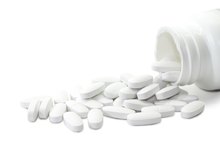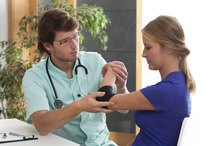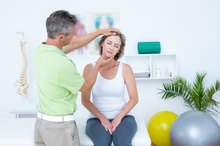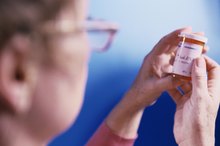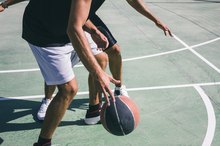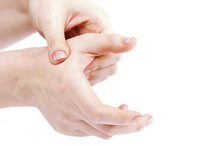What Are the Causes of Shoulder Pain & Shaking of the Hand?
Shoulder pain or discomfort accompanied by involuntary shaking of the hand is an uncommon combination of symptoms. Yet, according to the informational website The Spinal Columns, it may indicate a neurological or orthopedic health issue 1.
If you are experiencing serious medical symptoms, seek emergency treatment immediately.
Description
The involuntary shaking of the hand is medically identified as a tremor. A tremor, which usually occurs in the hand, can also occur in other parts of the body (feet, eye, head, and even the voice). According to Healthline, there are three types of tremors: static, which occur during resting mode; kinetic, which occur during intentional bodily movement, and postural or action tremors, which occur while holding the affected body part in a particular position or motion for an extended length of time (writing, typing).
Likely Causes
What are the Causes of a Trembling Head?
Learn More
When accompanied with pain in the shoulder, a "pinched" nerve is a probability 1. Shoulder pain on its own is an orthopedic issue. However, when accompanied with essential tremors, nerve compression due to a lack of blood flow is considered. According to The Spinal Columns, a pinched nerve can be a symptom of more serious problems, such as spondylitis, spondylosis, or muscle spasm 1. Consultation with a physician in this regard is highly recommended. Tremors that occur at rest and are accompanied with weakness, headache, abnormal tongue motion and muscle contractions should be treated as an emergency and immediately reported.
Stress, fatigue and anxiety can also cause tremors, though cigarettes and caffeine are predominant precursors, according to Healthline. Tremors, though often linked to the elderly, are not age related. Unspecified tremors that interfere with daily function should be thoroughly evaluated, as Parkinson's, multiple sclerosis, and stroke are commonly linked to tremors. .
- When accompanied with pain in the shoulder, a "pinched" nerve is a probability 1.
- Stress, fatigue and anxiety can also cause tremors, though cigarettes and caffeine are predominant precursors, according to Healthline.
Diagnosis
Blood tests (CBC, blood differential, thyroid, glucose), as well as a head CT scan, cranial MRI and urine tests are typically performed for diagnostic purposes. For evaluation of the shoulder, a standard X-ray may be performed and anti-inflammatories prescribed.
Biomedical Treatment
Alleviating Side Effects of Haldol
Learn More
For treatment of tremors, medicine may be prescribed contingent upon diagnosis. For treatment of nerve compression, increasing blood flow to the affected area is medically ideal, as is surgery for more severe cases.
Homeopathic Treatment
According to Mother Nature.Com, a homeopathic approach for treating a muscle spasm is also suggested for treating a pinched nerve, as, "you can get spasms from a pinched nerve," informs MN. In this regard, Mother Nature suggests applying moist heat, consuming more calcium and potassium, avoiding high acidic foods and simply taking it easy.
Related Articles
References
- Hochman MG, Zilberfarb JL. Nerves in a pinch: imaging of nerve compression syndromes. Radiol Clin North Am. 2004;42(1):221-45. doi:10.1016/S0033-8389(03)00162-3
- NIH National Institute of Neurological Disorders and Stroke. Pinched nerve information page. Updated March 27, 2019.
- AdventHealth Medical Group. Cauda equina syndrome.
- AAOS OrthoInfo. Cervical radiculopathy (pinched nerve). Updated June 2015.
- Dimitrova A, Murchison C, Oken B. Acupuncture for the treatment of peripheral neuropathy: A systematic review and meta-analysis. J Altern Complement Med. 2017;23(3):164-179. doi:10.1089/acm.2016.0155
- Conger A, Cushman DM, Speckman RA, Burnham T, Teramoto M, McCormick ZL. The Effectiveness of Fluoroscopically Guided Cervical Transforaminal Epidural Steroid Injection for the Treatment of Radicular Pain; a Systematic Review and Meta-analysis. Pain Med. 2019 Jun 10. pii: pnz127. doi:10.1093/pm/pnz127 [Epub ahead of print]
- Keating L, Treanor C, Sugrue J, Meldrum D, Bolger C, Doody C. A randomised controlled trial of multimodal physiotherapy versus advice for recent onset, painful cervical radiculopathy - the PACeR trial protocol. BMC Musculoskelet Disord. 2019 Jun 1;20(1):265. doi:10.1186/s12891-019-2639-4
Writer Bio
Kay Jenkins has been writing faith-related articles since 1996. Her articles have appeared in the "Twin Visions" weekly newspaper and Candler Women's "Celebrating Our Stories." She has written for several syndicated e-zines and books on demand. Jenkins holds dual master's degrees in divinity and theology from Emory University. She also has a Bachelor of Arts in sociology from Rutgers University.

